Studying How Extreme Heat Affects Urban and Rural Communities
Project Overview
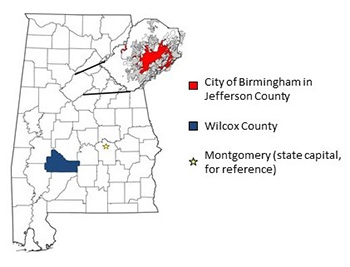
Adapted from a map created by DemocraticLuntz, licensed under the Creative Commons Attribution-ShareAlike 4.0 International (CC BY-SA 4.0) License.
Researchers and community partners who are part of the Environmental Health for Alabama Communities (ENACT) team are working together to understand how extreme heat events affect urban Birmingham and rural west central Alabama. Using a community-engaged approach, the partners are measuring individual and community-level heat and air exposure to identify risk factors for heat-related morbidity and mortality. This information can be used to lower the risk of heat-related health problems by developing educational tools and interventions that are tailored to urban and rural settings.
Community involvement includes:
- Designing and implementing study plans
- Choosing sites for neighborhood temperature monitors and maintaining those monitors
- Recruiting study participants and collecting data
- Communicating findings to stakeholders
Background

Extreme heat is commonly encountered in both Birmingham and west central Alabama, where normal summertime highs are around 90 degrees. Studies have linked extreme heat events with increased morbidity and mortality, but it is not known whether the risk from these events differs between rural and urban communities.
Using personal- and community-level measurements of pollution and heat exposures, the ENACT team is examining how those exposures differ between communities. They also want to find out whether data from weather stations or remote sensing instruments can predict individual-level heat exposure. Another goal of the study is to identify unique behavioral, physiological, or physical environmental risk factors for heat exposure in the urban and rural communities.
The project includes researchers from Virginia Polytechnic Institute and State University, the University of Alabama at Birmingham (UAB) Center for the Study of Community Health, and Johns Hopkins University. They are working with Birmingham’s Friends of West End, which educates, engages, and advocates for the city’s poorest and most medically underserved neighborhoods, and West Central Alabama Community Health Improvement League (WCACHIL), which employs community health advisors to educate and bring community members together on specific public health topics. WCACHIL has worked with UAB researchers on many projects through the Center for the Study of Community Health, which is funded by the Centers for Disease Control and Prevention.

Although the rural and urban communities in the study are quite different, both areas suffer from significant health and economic disparities. Approximately 210,000 people live in Birmingham, the largest city in Alabama; about 26 percent live below the poverty line, and 73 percent are African American. Rural west central Alabama, also known as the Black Belt region because of its rich black topsoil, includes some of the most economically disadvantaged counties in the U.S. The project is initially focused on Wilcox County, which has approximately 12,000 people; about 40 percent live below the poverty line, and 72 percent are African American.
Community Involvement
Community advisory boards (CABs) and community-wide workshops are helping to strengthen the problem-solving capacities of both researchers and community members. CAB meetings and community workshops also help provide the social context for developing an accurate picture of exposure and behaviors, physical environments, and physiological parameters associated with exposures.
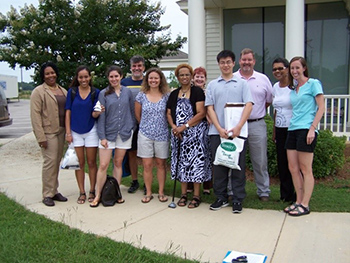
Wilcox County Community Advisory Board (CAB) Meeting and Monitor Deployment Team, May 2015
(Photo courtesy of Mary Evans)
The community workshops have been used in conjunction with satellite-derived maps to identify where to place a network of temperature monitors and passive volatile organic compound (VOC) samplers by examining where community members frequently spend time outdoors. In addition, volunteers from representative residential neighborhoods were recruited by community members to wear personal monitors.
A community-engaged approach was particularly important for this study because of the area’s history. Although the Tuskegee Syphilis Study eventually led to modern bioethics and the protection of human subjects, mistrust of the primarily white medical profession is still prevalent. In addition, the violence experienced during the Civil Rights Movement likely plays a role in the racial division seen today.
Outcomes
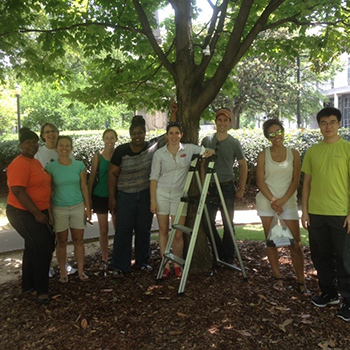
Birmingham Neighborhood Monitor Deployment Team, May 2015
(Photo courtesy of Kelvin Datcher)
Engaging the community. The CABs engage local experts, ensure research lines up with community priorities, and identify appropriate research strategies to address environmental concerns identified by community members in previous focus groups and surveys. CAB membership is balanced between researchers, community-based organizations or community members, and governmental or non-governmental issue-based organizations.
Emphasizing communication. The CABs identified several priorities, including communication and dissemination of project progress, as well as gathering feedback from the wider community. Annual workshops provide communication between residents and community/academic partners. Examples of these workshops include a panel for a breakout session, “The Rules of Engagement: Fully Involving Communities in Collaborative Research,” at the UAB Community Engagement Institute, as well as focus groups and presentations at the Black Belt Institute.
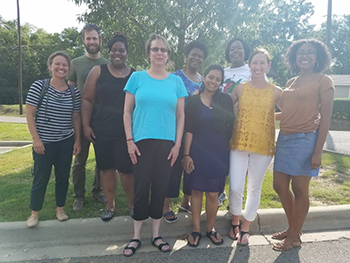
Birmingham Personal and Neighborhood Monitoring Team, July 2017
(Photo courtesy of Connor Wu)
Monitoring exposure. Community workshops, discussions, and planning with community partners identified representative rural and urban neighborhoods for placement of stationary temperature and VOC monitors. Community partners identified specific locations for monitor placement and collaborated with the project team on checking and collecting the monitors at the end of the measurement period.
For personal exposure monitoring, community and academic partners worked together to plan and design the study. During the summer of 2017, the partners recruited, consented, trained, and followed up with 180 study participants from whom personal temperature and pedometer measurements were collected. Researchers will compare personal exposure measures to stationary monitors and data from remote sensors to find out how well each method can measure or predict individual-level heat exposure.
Challenges
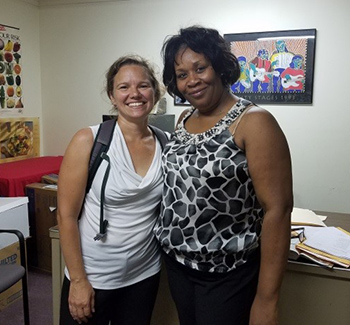
Wilcox County Personal and Neighborhood Monitoring Team, July 2017
(Photo courtesy of Connor Wu)
The study partners encountered challenges that are common to community-engaged research. For example, it took time for the academic researchers and community partners to develop relationships and trust. It was also important to understand and negotiate the differing priorities and timelines of the community partners and academic researchers. In addition, communicating effectively required balancing everyone’s preferences for, and the feasibility of, various communication methods, such as in-person meetings, phone calls, emails, or a shared webpage.
Contact
-
Julia M. Gohlke, Ph.D.
Department of Population Health Sciences;
Virginia Polytechnic Institute and State University -
Tel 540-231-7880
[email protected]


